The aggregate production of the livestock and poultry sector in Region I posted a 1.69 percent gain in 2017. Production increments of 2.18 percentand 1.18 percent were realized during the 1st and 2nd semesters of the year, respectively.
The livestock subsector which shared 58.51 percent in the aggregate production came up with a 1.77 percent output gain in 2017. Hog production, which was the leading source of the subsector’s growth, increased by 4.06 percent.
Likewise, poultry production gained by 1.57 percent in 2017. It accounted for 41.49 percent of the total production. Chicken eggs and duck eggs posted output gains. On the other hand, production of chicken and duck in liveweight metric tons declined by 0.86 and 1.16 percent, respectively.
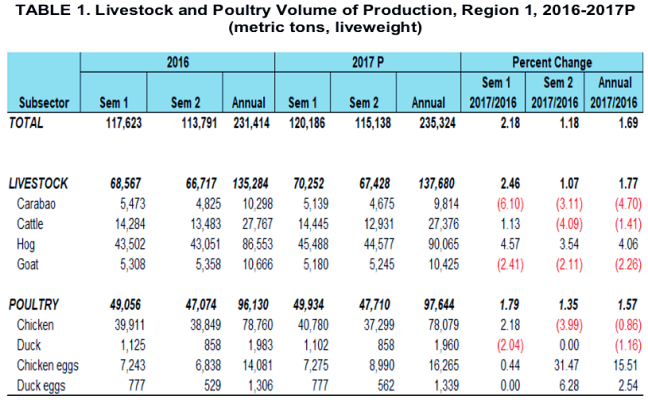
Note : P- Preliminary
In terms of distribution by animal and product type, swine contributed the biggest to the total production with a share of 38.27 percent, followed by chicken with 33.18 percent, cattle with 11.63 percent, chicken eggs with 6.91 percent, goat with 4.43 percent, carabao with 4.17 percent, and meager shares of 0.83 percent and 0.57 percent for duck and duck eggs, respectively.
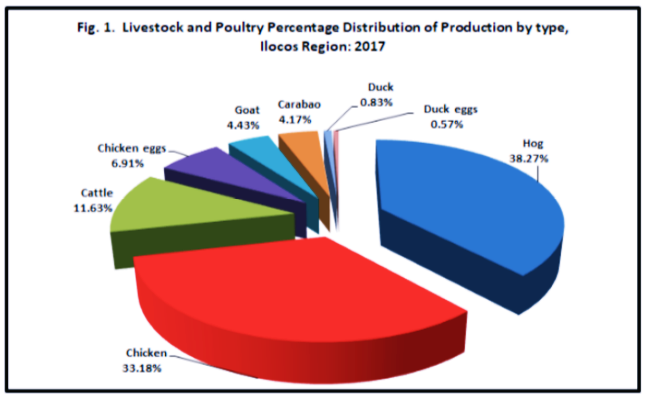
CARABAO
In 2017, the volume of carabao production in Region 1 was 9,814 metric tons liveweight. Region I contributed 6.80 percent to the national production of 144,409 metric tons. It ranked 6th among the top ten carabao producing regions.
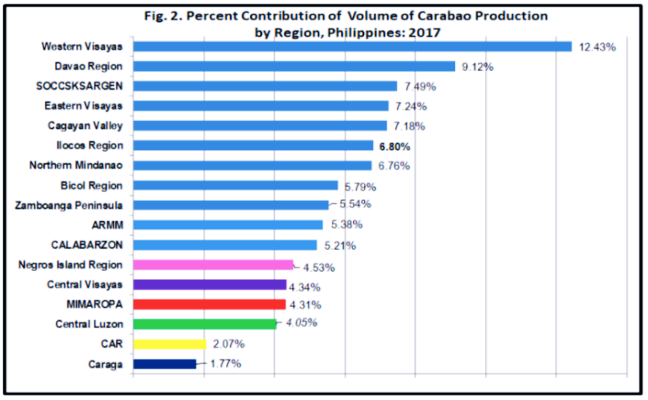
The region’s carabao production registered a drop of 4.70 percent as compared to last year’s level of 10,298 metric tons liveweight. The provinces of La Union and Pangasinan posted production drop of 7.37 percent and 9.46 percent, respectively. On the other hand, carabao production of Ilocos Norte and Ilocos Sur increased by 9.49 percent and 9.44 percent, respectively.
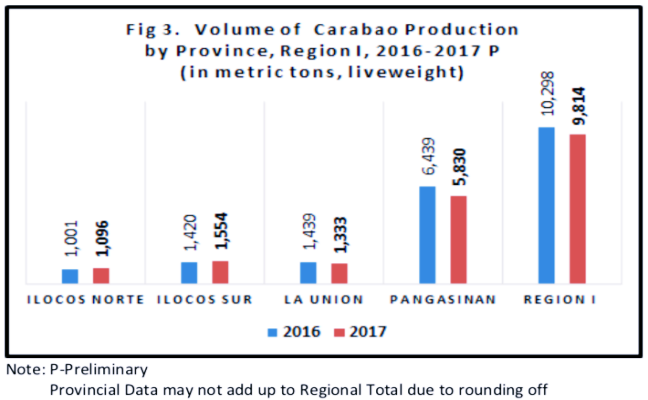
In terms of inventory as of January 1, 2017, the total number of carabaos in Region I was estimated at 165,860 heads, an increase of 1.40 percent from previous years’headcount. Total inventory further increased to 166,608 heads as of July 1, 2017. There was building up of stocks as more were kept for breeding in backyard farms especially caracows. Backyard farms as of July 1, 2017 accounted 99.74 percent of the total carabao population, while the remaining 0.26 percent were accounted in commercial farms.
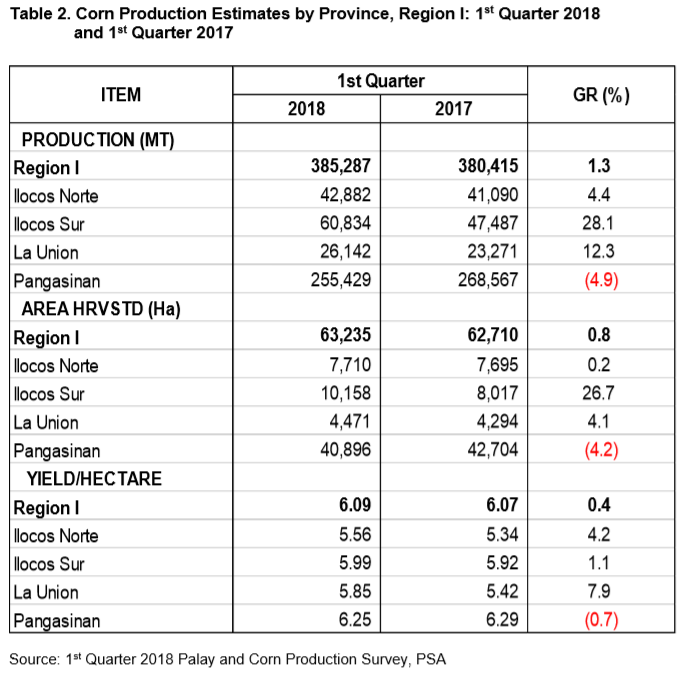
CATTLE
The region’s cattle production in 2017 was 27,376 metric tons liveweight. Region I ranked 3rd in the country’s cattle production of 266,301 metric tons with a share of 10.28 percent.
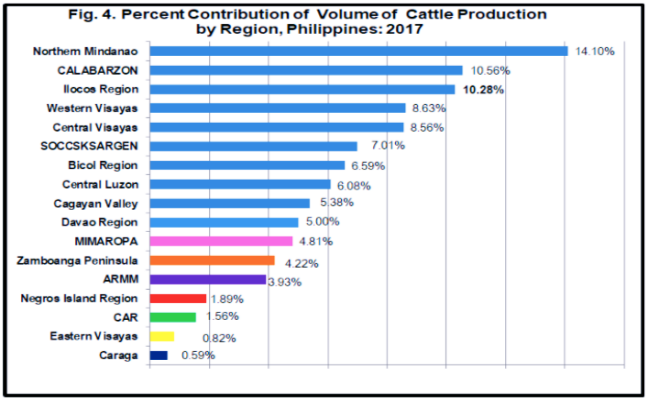
As compared to last year’s production, cattle production in Region I was 1.41 percent lower. The production drop was noted in Pangasinan at 5.54 percent, while Ilocos Norte, Ilocos Sur and La Union increased in production by 6.15 percent, 0.31 percent and 1.94 percent, respectively.
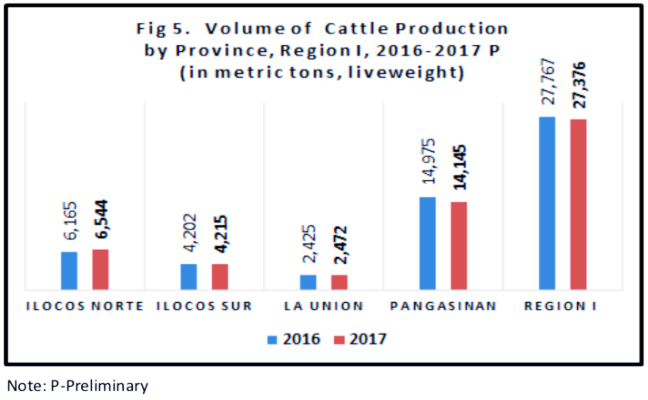
As of January 1, 2017, region’s total count of cattle was 300,323 heads. This was lower by 0.42 percent as compared to the same period last year. This number further decreased to 297,050 heads as of July 1, 2017. More were sold live due to encouraging price and high demand from viajeros bound to provinces outside the region during the 1st semester. About 99.13 percent of the total inventory as of July 1, 2017 were in the backyard farms, while the remaining 0.87 percent were in the commercial farms.

SWINE
In 2017, the region’s hog production reached 90,065 metric tons liveweight. The total production in the country was 2,265,015 metric tons liveweight. Region 1 ranked 9thamong the top ten producers with a share of 3.98 percent.
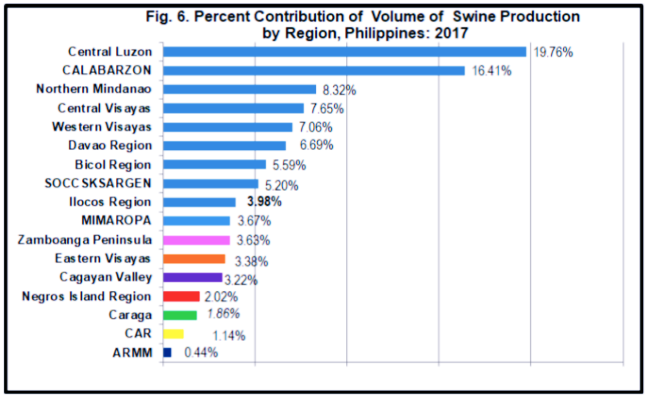
The region’s production output of 90,065 metric tons was 4.06 percent higher than lastyear’s level of 86,553 metric tons liveweight. The provinces of Ilocos Norte and Pangasinan registered positive production growths with 6.29 percent and 6.61 percent, respectively. On the otherhand, hog production in Ilocos Sur and La Union decreased by 0.07 and 1.28 percent, respectively.
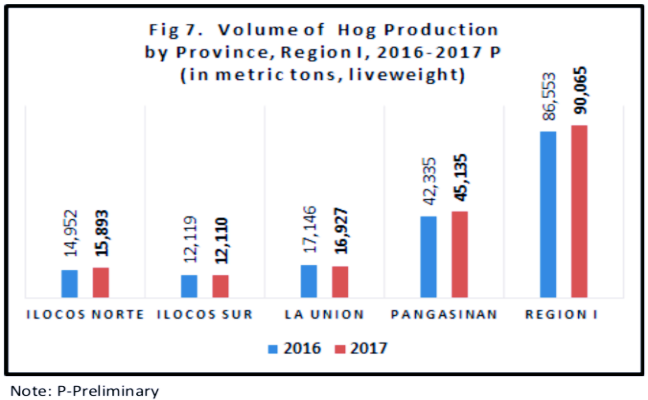
Total inventory of swine as of January 1, 2017 was 577,227 heads, higher by 3.93 percent than last year. Out of this total inventory, 80.75 percent were in backyard farms, while 19.25 percent were in commercial farms. As of July 1, 2017, the number lowered to 557,358 heads, wherein 79.43 percent were in backyard farms, while 20.57 percent were in commercial farms.

GOAT
Production of goat in 2017 was 10,425 metric tons liveweight. Region 1 remained as the number one producer of goat in the country with a share of 13.38 percent to the national production of 77,338 metric tons.
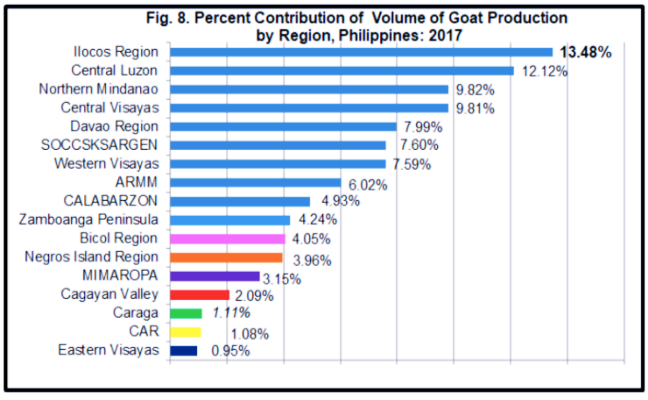
The region’s goat output posted a drop of 2.26 percent as compared to the 2016 level of 10,666 metric ton liveweight. La Union and Pangasinan contributed to said decline in production of 7.77 percent and 4.39 percent, respectively.
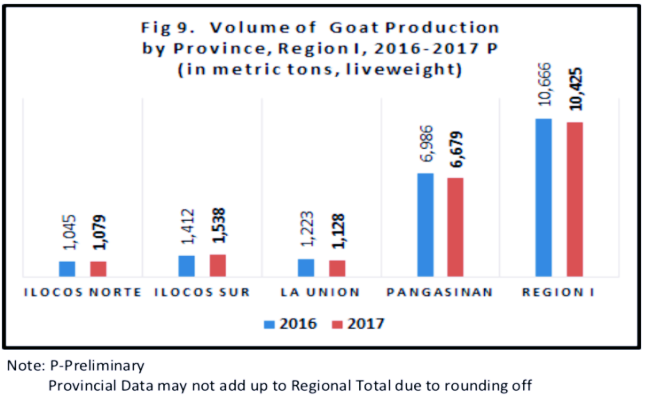
As of January 1, 2017, total inventory of goat was 419,821 heads. It grew by 3.32 percent from the previous year’s inventory of 406,321 heads. Inventory further increased to 445,657 heads as of July 1, 2017, as more backyard raisers were building up stocks specially breeders. Share of backyard farms as of July 1, 2017 was 98.79 percent or 440,266 heads while the remaining 1.21 percent or 5,391 heads of goat were raised in commercial farms.

CHICKEN
The region’s volume of chicken production at 78,079 metric tons decreased by 0.86 percent in 2017. However, chicken egg production in 2017 posted an increase of 15.51 percent growth relative to 2016 (Table 1). Region 1 ranked 6th among the top producers of chicken in the country’s production of 1,745,888 metric tons with a share of 4.47 percent.

By provincial level, Ilocos Norte had a production of 6,319 metric tons and was the only province with an output gain of 0.70 percent. Ilocos Sur, La Union and Pangasinan posted decreases in production at 5.14 percent, 1.35 percent and 0.46 percent, respectively.

Total inventory of chicken posted a decrease of 20.36 percent at the start of 2017. However, total inventory of chicken as of July 1, 2017 increased by 10.61 percent as commercial broiler farms were able to have more stocks attributed to availability of Day-Old -Broilers relative to last year of same period.

DUCK
The total volume of duck production was estimated at 1,960 metric tons liveweight. Region 1 ranked 5th in the country’s total duck output of 31,091 metric tons with a contribution of 6.30 percent.

The duck production in Region 1 was 1.16 percent lower from last year’s level of1,983 metric tons liveweight. The provinces of La Union and Pangasinan posted production decline of 16.88 percent and 1.98 percent, respectively. On the other hand, production of Ilocos Norte and Ilocos Sur increased by 20.21 percent and 31.67 percent, respectively.

As of January 1, 2017, total inventory of duck was 382,687 heads. Said number declined by 3.58 percent as compared to the same period last year. The meager contraction was contributed by the decrease of duck count in commercial farms by 76.90percent.Thiswasattributedtoclosure ofsomeduckeggfarmsinPangasinan.
However, inventory of duck as of July 1, 2017 reached 400,411 heads, a growth of 0.95 percent. There was notable increase of duck raisers in backyard farms. About 98.17 percent of the total duck inventory were in the backyard farms, while the remaining 1.83 percent were in the commercial farms.

TECHNICAL NOTES
-
Volume of Production. Refers to the volume of locally-raised animals disposed for slaughter or dressing which include animals exported or shipped- out for slaughter or dressing. This is expressed in metric tons, liveweight.
-
Livestock – farm animals kept or raised for consumption, work or leisure. In general, poultry is separated as a distinct group of farm animals. For purposes of census and surveys, livestock covers only those that are tended and raised by an operator.
-
Poultry - a collective term for all domesticated avian for the purpose of food consumption or, the carcass of such avian dressed/processed for human consumption.
-
Animal Inventory (also, Animal Population) – the number of domesticated animals in head present in the farm at specific reference date.
-
Backyard Farm/Raiser- refers to any farm or household raising at least one head of animal or bird and does not qualify as a commercial farm.
-
Commercial Livestock Farm/Operator - refers to any livestock operator or farm which operation satisfies at least one of the following conditions: a) at least 21 head of adults and zero young b) at least 41 head of young animals c) at least 10 head of adults and 22 head of young animals.
-
Commercial Poultry Farm/Operator- refers to any poultry operator or farm which operation satisfies at least one of the following conditions: a) 500 layers or 1,000 broilers b) 100 layers and 100 broilers if raised in combination c) 100 head of duck regardless of age.
-
Swine. A non-ruminant, cloven-footed animal belonging to family suidae with simple stomach, having a snout, large number of mammary glands, thin skin, and heavy bristles. It is also called hog or pig.
Acronyms used in this report
-
NIR -Negros Island Region
-
CAR -Cordillera Administrative Region
-
ARMM- Autonomous Region in Muslim Mindanao
-
MIMAROPA- Occidental Mindoro, Oriental Mindoro, Marinduque, Romblon, Palawan
-
CALABARZON -Cavite, Laguna, Batangas, Rizal, Quezon
-
SOCCSKSARGEN -South Cotabato, Cotabato City, Sultan
SOCRATES L. RAMORES
Regional Director

